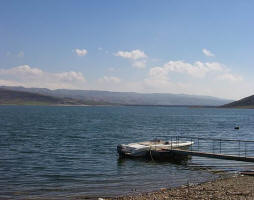Initiatives & Projects
 Improved System for Water Desalination by Solar Energy
Improved System for Water Desalination by Solar Energy
A novel design has been proposed for a solar still, designed to produce
fresh water out of seawater or brackish water. A simulation model has been
developed. Based on simulation results, a deteailed design of a prototype
system will next be developed.
| Project number | n/a | ||
|---|---|---|---|
| Subject(s) | DRINKING WATER AND SANITATION : COMMON PROCESSES OF PURIFICATION AND TREATMENT , ENERGY , SANITATION -STRICT PURIFICATION PROCESSES | ||
| Geographical coverage | Israel | ||
| Budget (in €) | 73000 | ||
| Programme | Pilot | ||
| Web site | http://www.technion.ac.il/rdl/Solar_Energy.html | ||
| Results | In the proposed system, the solar heat is utilized more than once through
recovery of the heat of condensation in a manner somewhat similar to
multi-effect desalination. Unlike in conventional designs where the moist
air in the solar still is practically stagnant, the present design generates
circulation of the humid air. The air absorbs the humidity in a part of the
still exposed to the sun, circulates and allows the humidity to condense in
another, shaded part while preheating the feed water. Heat can be stored in
the feed water so as to obtain additional evaporation and condensation that
can continue after sunset and at night. Several design variations are
envisioned based on this principle. Work on this project has been in progress for about one year, and concentrated mainly on the design and modeling of the solar still. A simulation model has been developed which describes the essential processes taking place in the system: The heating of the feed water by solar energy on the evaporator side (both direct and indirect heating are considered); the condensation of product water on the condenser side, while preheating the entering feed water; and the circulation of humid air from the evaporator side to the condensation side to transport the water. Heat and mass transfer coefficients, which are important design parameters, have been estimated as best as possible, but will have to be actually measured in the experimental system. Based on the simulation results, a detailed design of a prototype system will next be developed. The system will be tested to confirm the results of the simulation and obtain much-needed data on operating parameters. Preliminary experiments conducted at the Solar Laboratory of the Faculty of Mechanical Engineering have yielded an output greater by 40% relative to conventional stills. Further improvements and optimization are in order, and are expected to yield still better results. |
||
| Period | 01/01/2006 | ||
Login to add a comment
 you are not logged in
you are not logged in





